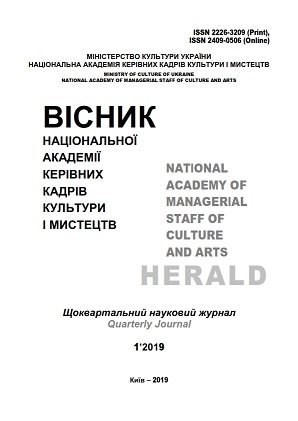Imperative Function of Aesthetic
Imperative Function of Aesthetic
Author(s): Mykola Anatolyevich ZhurbaSubject(s): Aesthetics, Social Philosophy, Culture and social structure , Sociology of Culture, Ontology
Published by: Національна академія керівних кадрів культури і мистецтв
Keywords: aesthetic imperative; fiction art; spirituality; beauty; economic expediency; quasi-beauty; culture;
Summary/Abstract: The purpose of the study is to consider the concept of aesthetic imperative as an effective mechanism for ―reformatting a person, awakening his soul in a contemporary deformed cultural space. The methodology of the study. In the article the following methods are used: the comparative and historical method, which allows to consider the existing approaches to the definition of the ontological essence of aesthetic imperativeness in human life; the pragmatic method, which is used for extrapolation of aesthetic expediency into economic expediency; the dialectical method, which makes it possible to consider the aesthetic and economic expediencies in interconnection; the phenomenological method is associated with the peculiarities of manifestation of aesthetic imperativeness based on concrete examples derived from the classical literature and the method of abstraction, which allows us to investigate the otherness of aesthetic imperativeness in postmodernism. The scientific novelty. The study of aesthetic imperativeness in human life activity is carried out and the approaches to its study based on the analysis of classical literature are outlined, and to the aesthetic thesaurus there is proposed a concept of quasi-beauty as a kind of aesthetic phenomenon in the structure of human life activity, that is subordinated to the logic of economic or consumer expediency. Conclusions. Without pretending to comprehensive study of all the issues related to the subject, this study intended to draw attention to the problems of aesthetic imperativeness. We have found that various social phenomena as manifestations of human activity appear in the form of unconscious need: they contain hidden aesthetic imperativeness. Writers, artists, poets, directors, architects, designers and others describe it through the art and thereby bring it in the realities of social being. Thus, the aesthetic expediency appears as a phenomenon of imperativeness and becomes an impulse for changing the forms of life itself. The classical heritage provides the foundation for understanding and research of the aesthetic imperativeness, not only in art, but as one of the modulators of human behavior and activity.
Journal: Вісник Національної академії керівних кадрів культури і мистецтв
- Issue Year: 2019
- Issue No: 1
- Page Range: 39-44
- Page Count: 6
- Language: English

